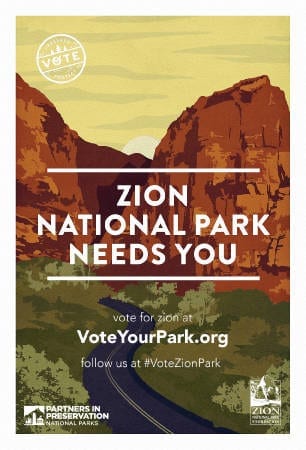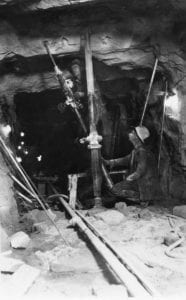
By Lyman Hafen
The historically iconic Zion Tunnel is dear to the hearts of people across the country and around the world. During the month of June, everyone who cares about the Zion Tunnel Preservation Project can vote online to support a substantial grant that, if won, will provide funding to preserve and maintain the Zion Tunnel into the future.
The grant is funded by American Express through the National Trust for Historic Preservation as part of their Partners in Preservation initiative. Twenty national park historic preservation projects, including the Zion Tunnel Preservation Project, have been named finalists for a total of $2 million in funding, all of this to celebrate the centennial anniversary of the National Park Service. National Geographic is hosting the online voting, which began May 25 and continues through July 5. You can vote once a day for the project of your choice, and the winning projects will be announced soon after July 5. To vote, go to VoteYourPark.org. For detailed information on the “Zion Tunnel Preservation Project” and how you can support it, go to the Zion National Park Foundation website at zionpark.org.
 In the region we now know as the State of Utah, it has always been easier to travel north and south than east and west. It has to do with geological forces deep in the earth. And the result is that most of the mountains, faults, fissures, and fractures in red rock country run north and south, leaving openings for north-south travel through the valleys while rugged ridges, canyons, and plateaus hamper movement east and west. So it’s always been easier to get from St. George to Salt Lake City than, say, from St. George to San Juan County.
In the region we now know as the State of Utah, it has always been easier to travel north and south than east and west. It has to do with geological forces deep in the earth. And the result is that most of the mountains, faults, fissures, and fractures in red rock country run north and south, leaving openings for north-south travel through the valleys while rugged ridges, canyons, and plateaus hamper movement east and west. So it’s always been easier to get from St. George to Salt Lake City than, say, from St. George to San Juan County.
With the advent of automobiles and independent tourism, Southern Utah boosters got serious in the early 1920s about figuring out a way to exit and enter Zion Canyon from the east. As the nation started to realize the amazing beauty of this area, voices began to be heard in Washington demanding better access. It took a lot of time, money, and ingenuity, but when the task was accomplished, three magnificent national parks — Zion, Bryce, and Grand Canyon — were brought within reach of a fast-traveling public.
Centuries ago, Native Americans built the first trail out the east side of Zion Canyon. Some 20 steps chiseled into the sheer rock near today’s Weeping Rock parking lot attest to the fact that the Paiutes went out through Echo Canyon over the East Rim.
In the late 1800s, a local stockman named John Winder built the first pioneer livestock trail up and over the same rock face. In the years following the designation of Zion Canyon as a national monument in 1909, local park employees did extensive work in remodeling Winder’s trail and building others. But the idea of an actual road out the canyon’s east walls seemed beyond the reach of everyone.
Then, in 1923, Howard Means, chief engineer of the State of Utah, and B.J. Finch, a district engineer for the federal government, were sent to Zion Canyon to determine, once and for all, if a road could be built out the east side.
Their initial determination was that it was impossible.
Then someone introduced them to John Winder, who showed them where the road should go up Pine Creek Canyon. They surveyed the route and determined it would be feasible. Their biggest hurdles would be engineering a mile-long tunnel through the stone towers and convincing Congress to appropriate money for such a project.

What they proposed to do, including constructing 3 1/2 miles of switchback road up the talus slope of the canyon and the one-mile tunnel through solid sandstone, would be impossible to get approved and funded today, but the country’s can-do attitude in the mid-1920s opened the way. By the summer of 1927, the Zion-Mt. Carmel Highway and Tunnel had been approved and funded. Area promoters and politicians — along with the National Park Service under its first director, Stephen Mather — had convinced a reluctant Congress that the project would work.
On September 27, 1927, the first six men hired by the Nevada Contracting Company started clearing a right-of-way up Pine Creek Canyon. Over the next two years, the number of workers would reach more than 200, and what they accomplished in those two years with limited technology and primitive equipment is still hailed as a wonder today.
It took just 11 months and 12 days to blast the tunnel through the mountain. By the end of 1929, the road was complete enough that a car could be driven over the entire route. But it wasn’t until July 4, 1930, that all the work was finished, and that’s the day dignitaries from across the country gathered near the tunnel entrance to dedicate the engineering marvel and open it to the public.
 Over the ensuing decades, the tunnel has become as much an icon of Zion National Park as the Great White Throne or Angels Landing. For many, their first experience driving through the tunnel is the overriding memory of Zion, something they carry with them the rest of their lives.
Over the ensuing decades, the tunnel has become as much an icon of Zion National Park as the Great White Throne or Angels Landing. For many, their first experience driving through the tunnel is the overriding memory of Zion, something they carry with them the rest of their lives.
Now we all have the opportunity to play a part in the tunnel’s future by voting for a grant that will help preserve it for decades to come. Between May 25 and July 5, you can vote once a day for this important grant by going to VoteYourPark.org.



